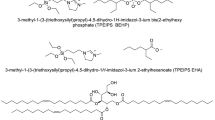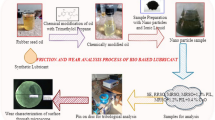Abstract
The public awareness in environmental issues has been constantly growing. Lubricants are applied in many diverse areas; therefore, their environmental acceptability has become increasingly important. In this paper, a kind of eco-friendly high-temperature lubricant was prepared by mixing castor oil with lithium bis(trifluoromethylsulfonyl)imide (LiTFSI) in molar ratios of 1:0.5, 1:1, and 1:1.5. Thermal and rheological analysis indicates that the in situ formed ILs, [Li(castor oil)]TFSI, with various molar ratios, are more resistant to high temperatures and substantially stronger than the pure castor oil. Tribological test results shown that the ILs have excellent friction reduction and antiwear properties for lubrication of steel/steel contacts at 200 °C. Moreover, the tribological performances of these lubricants were also better than those of epoxidized soybean oil fluid, which is an environment-friendly lubricant and has high oxidative stability. XPS analytical results indicated that a boundary lubrication film composed of Fe2O3, Fe3O4, FeOOH, FeSO4 or Fe2(SO4)3, FeF2, FeF3, and C–O bonding was formed on the worn steel surface, and the film is believed to be responsible for the excellent tribological properties of [Li(castor oil)]TFSI using at elevated temperature.










Similar content being viewed by others
References
Nagendramma, P., Kaul, S.: Development of ecofriendly/biodegradable lubricants: an overview. Renew. Sustain. Energy Rev. 16, 764–774 (2012)
Wilson, B.: Lubricants and functional fluids from renewable sources. Ind. Lubr. Tribol. 50, 6–15 (1998)
Gryglewicz, S., Piechocki, W., Gryglewicz, G.: Preparation of polyol esters based on vegetable and animal fats. Bioresour. Technol. 87, 35–39 (2003)
SathwikChatra, K.R., Jayadas, N.H., Satish, V.K.: Natural oil-based lubricants. In: Nosonovsky, M., Bhushan, B. (eds.) Green tribology-biomimetics, energy conservation and sustainability, p. 287. Springer, Heidelberg (2012)
Karmakar, G., Ghosh, P.: Soybean oil as a biocompatible multifunctional additive for lubricating oil. ACS Sustainable Chem. Eng. 3, 19–25 (2015)
Karmakar, G., Ghosh, P.: Green additives for lubricating oil. ACS Sustainable Chem. Eng. 1, 1364–1370 (2013)
Mortier, R.M., Fox, M.F., Orszulik, S.T.: Aviation lubricants. In: Lansdown, A.R., Lee, S. (eds.) Chemistry and Technology of Lubricants, pp. 345–352. Springer, New York (2010)
Asadauskas, S., Perez, J.M., Duda, J.L.: Lubrication properties of castor oil-potential basestock for biodegradable lubricants. Lubr. Eng. 53, 35–40 (1997)
Kar, P., Asthana, P., Liang, H.: Formation and characterization of tribofilm. J. Tribol. 130, 4201–4206 (2008)
Chadha, B.R., Gupta, M., Gupta, L.R.: Some experimental studies of lubricants in a two-stroke methanol engine. J. Synth. Lubr. 8, 295–306 (1992)
Ye, B., Yu, W.L., Wang, B., Tao, D.H.: Rheological and tribological characteristics of chemically modified castor oil. Lubr. Eng. 1, 37–38 (2005)
John, W.G., Daniel, P.G.: Influence of fatty acid methyl esters from hydroxylated vegetable oils on diesel fuel lubricity. Bioresour. Technol. 96, 851–855 (2005)
Stevens, C.: Practical pointers for grease and antiseize selection. Plant Eng. 52, 67–69 (1998)
Loomis, W.R., Fusaro, R.L.: Overview of liquid lubricants for advanced aircraft engines. NASA Tech. Memo. 83529 (1982)
Wu, X.H., Liu, J.M., Zhao, Q., Zhang, M., Zhao, G.Q., Wang, X.B.: In situ formed ionic liquids in polyol esters as high performance lubricants for steel/steel contacts at 300 °C. ACS Sustain. Chem. Eng. 3, 2281–2290 (2015)
Rudnick, L.R., Shubkin, R.L.: Synthetic lubricants and high-performance functional fluids, revised and expanded. Taylor & Franci, New York (1999)
Cavdar, B.: Effect of temperature, substrate type, additive and humidity on the boundary lubrication in a linear perfluoropolyalkylether fluid. Wear 206, 15–23 (1997)
Adhvaryu, A., Erhan, S.Z.: Epoxidized soybean oil as a potential source of high-temperature lubricants. Ind. Crops Prod. 15, 247–254 (2002)
Fan, M.J., Song, Z.H., Liang, Y.M., Zhou, F., Liu, W.M.: In situ formed ionic liquids in synthetic esters for significantly improved lubrication. ACS Appl. Mater. Interfaces 4, 6683–6689 (2012)
Fan, M.J., Liang, Y.M., Zhou, F., Liu, W.M.: Dramatically improved friction reduction and wear resistance by in situ formed ionic liquids. RSC Adv. 2, 6824–6830 (2012)
Song, Z.H., Cai, M.R., Liang, Y.M., Fan, M.J., Zhou, F., Liu, W.M.: In situ preparation of anti-corrosion ionic liquids as the lubricant additives in multiply-alkylated cyclopentanes. RSC Adv. 3, 21715–21721 (2013)
Song, Z.H., Fan, M.J., Liang, Y.M., Zhou, F., Liu, W.M.: Lithium-based ionic liquids: in situ-formed lubricant additive only by blending. Tribol. Lett. 49, 127–133 (2013)
Shah, F.U., Glavatskih, S., Antzutkin, O.N.: Boron in tribology: from borates to ionic liquids. Tribol. Lett. 51, 281–301 (2013)
Palacio, M., Bhushan, B.: A review of ionic liquids for green molecular lubrication in nanotechnology. Tribol. Lett. 40, 247–268 (2010)
Zhou, F., Liang, Y.M., Liu, W.M.: Ionic liquid lubricants: designed chemistry for engineering applications. Chem. Soc. Rev. 38, 2590–2599 (2009)
Qu, J., Truhan, J.J., Dai, S., Luo, H., Blau, P.J.: Ionic liquids with ammonium cations as lubricants or additives. Tribol. Lett. 22, 207–214 (2006)
Yoshida, K., Nakamura, M., Kazue, Y., Tachikawa, N., Tsuzuki, S., Seki, S., Dokko, K., Watanabe, M.: Oxidative-stability enhancement and charge transport mechanism in glyme–lithium salt equimolar complexes. J. Am. Chem. Soc. 133, 13121–13129 (2011)
Allauddin, S., Narayan, R., Raju, K.V.S.N.: Synthesis and properties of alkoxysilane castor oil and their polyurethane/urea–silica hybrid coating films. ACS Sustain. Chem. Eng. 1, 910–918 (2013)
Wang, B.G., Wang, X.B., Lou, W.J., Hao, J.C.: Rheological and tribological properties of ionic liquid-based nanofluids containing functionalized multi-walled carbon nanotubes. J. Phys. Chem. C 114, 8749–8754 (2010)
Ferry, J.D.: In Viscoelastic Properties of Polymers. Wiley, New York (1980)
Kim, D., Archer, L.A.: Nanoscale organic–inorganic hybrid lubricants. Langmuir 27, 3083–3094 (2011)
Wu, X.H., Wang, X.B., Liu, W.M.: Tribological properties of naphthyl phenyl diphosphates as antiwear additive in polyalkylene glycol and polyurea grease for steel/steel contacts at elevated temperature. RSC Adv. 4, 6074–6082 (2014)
Shah, F.U., Glavatskih, S., Höglund, E., Lindberg, M., Antzutkin, O.N.: Interfacial antiwear and physicochemical properties of alkylborate-dithiophosphates. ACS Appl. Mater. Interfaces 3, 956–968 (2011)
Qu, J., Bansal, D.G., Yu, B., Howe, J.Y., Luo, H.M., Dai, S., Li, H.Q., Blau, P.J., Bunting, B.G., Mordukhovich, G., Smolenski, D.J.: Antiwear performance and mechanism of an oil-miscible ionic liquid as a lubricant additive. ACS Appl. Mater. Interfaces 4, 997–1002 (2012)
Naumkin, A.V., Kraut-Vass, A., Gaarenstroom, S.W., Powell, C.J.: NIST X-ray Photoelectron Spectroscopy Database. https://srdata.nist.gov/xps/Default.aspx
Sun, Y.B., Hu, L.T., Xue, Q.J.: Tribological properties and action mechanism of N, N-dialkyl dithiocarbamate-derived S-hydroxyethyl borate esters as additives in rapeseed oil. Wear 266, 917–924 (2009)
Zhao, G.Q., Wu, X.H., Li, W.M., Wang, X.B.: Hydroquinone bis(diphenyl phosphate) as an antiwear/extreme pressure additive in polyalkylene glycol for steel/steel contacts at elevated temperature. Ind. Eng. Chem. Res. 52, 7419–7424 (2013)
Cai, M.R., Liang, Y.M., Zhou, F., Liu, W.M.: Tribological properties of novel imidazolium ionic liquids bearing benzotriazole group as the antiwear/anticorrosion additive in poly(ethylene glycol) and polyurea grease for steel/steel contacts. ACS Appl. Mater. Interfaces 3, 4580–4592 (2011)
Acknowledgements
The authors are thankful for financial support of this work by “973” Program (2013CB632301) and national natural science foundation of china (NSFC 51475445).
Author information
Authors and Affiliations
Corresponding authors
Ethics declarations
Conflict of interest
The authors declare no competing financial interest.
Rights and permissions
About this article
Cite this article
Wu, X., Zhao, G., Wang, X. et al. Preparation of High-Temperature Lubricants by Blending Castor Oil with Lithium Bis(trifluoromethylsulfonyl)imide. Tribol Lett 65, 51 (2017). https://doi.org/10.1007/s11249-017-0833-9
Received:
Accepted:
Published:
DOI: https://doi.org/10.1007/s11249-017-0833-9




